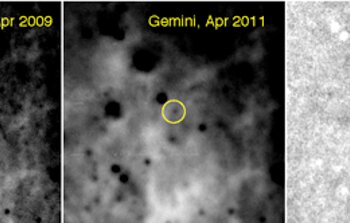Gemini Helps Dissect an X-ray Surprise in M83
April 27, 2012

An international team uses Gemini to follow up on a rare transient X-ray source discovered by the Chandra X-ray Observatory in late 2010 within the nearby galaxy M83. Observations with the Gemini South telescope are the first to capture the object’s optical glow and initiate additional observations with the Hubble Space Telescope. From the Gemini/HST data a characterization emerges of a black hole with an unexpectedly low-mass, highly evolved giant companion, whose atmosphere is intermittently streaming material into an accretion disk feeding the black hole.
Because of its relative closeness, face-on orientation, and enhanced level of star formation, spiral galaxy M83 is a favorite among astronomers - professional and amateur alike. M83 is also a prolific host to supernovae explosions (and their remnants), making it a frequent target for Gemini scientists. In April of 2011, Frank Winkler (Middlebury College) and Bill Blair (Johns Hopkins University) used Gemini South to make classically-scheduled observations of the famous galaxy - their timing, it turns out, was exquisite…
In April 2011, as Blair and Winkler worked to obtain spectra of supernova remnant candidates in M83, they requested (and were granted) permission to reprogram part of their Gemini South observations. Their intent was to look for an optical counterpart to a transient X-ray source in M83, which had been in an ultraluminous state since the Chandra X-ray Observatory first detected it in December 2010. Such powerful X-ray transients are extremely rare. They’re usually associated with very young stars in regions of recent star formation. But this new source was in an uncrowded inter-arm region of the galaxy and provided an opportunity that couldn’t be ignored.
The data they obtained using the Gemini Multi-Object Spectrograph in imaging mode were the first to reveal a faint blue stellar source at the position of the Chandra source. As Magellan and HST images dating to August-September 2009 showed no blue object in the same location, the Gemini data indicate that the optical source had only recently “turned on.” The wheels of science quickly began rolling.
“We were really curious whether there had been any optical flare-up along with this prodigious new X-ray source, and GMOS, which can readily be converted from spectroscopy to imaging, was just the right tool to find out,” Winkler said. “The detection from Gemini was crucial for obtaining Director’s Discretionary time on Hubble, and the Hubble data enabled us to really constrain the pre-outburst source,” added Blair.
In short-order, the Hubble Space Telescope confirmed the optical source first detected by Gemini and pinned down its exact location. With these Gemini and HST data in hand, a characterization of the event’s nature began to emerge, which is published online now and will be in the May 20, 2012 issue of The Astrophysical Journal. The authors suggest that this rare X-ray flare-up is due to a binary system consisting of a 40-100 solar mass black hole and a low-mass giant, whose atmosphere is overflowing onto the black hole. The low-mass companion is not typical of ULXs; most of the previous studies find that the donor companions have high masses and are associated with active star forming regions. This new work in M83 shows an alternate route to forming ULXs. The infalling matter forms an accretion disk that orbits the black hole and generates intense radiation in the process. The blue optical emission seen by Gemini and HST during the outburst comes from the outer portion of this same irradiated accretion disk.
When last seen by Chandra in late 2011, the ULX remained in the bright state with no signs of slowing down its current binge.
In addition to Winkler and Blair, the complete science team includes lead author Roberto Soria from Curtin University in Australia, Kip Kuntz of Johns Hopkins University, Knox Long of STScI (PI on the Chandra program), Paul Plucinsky from the Harvard-Smithsonian Center for Astrophysics, and Brad Whitmore, also from STScI.
